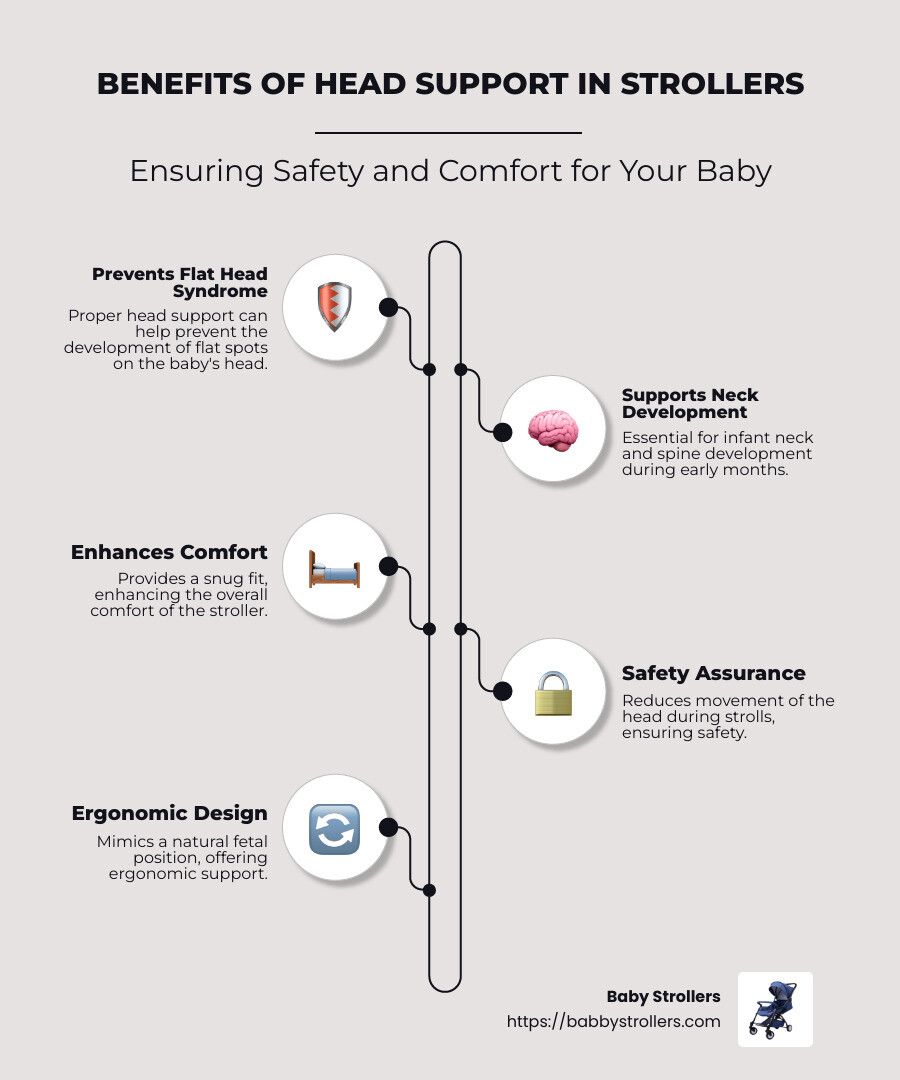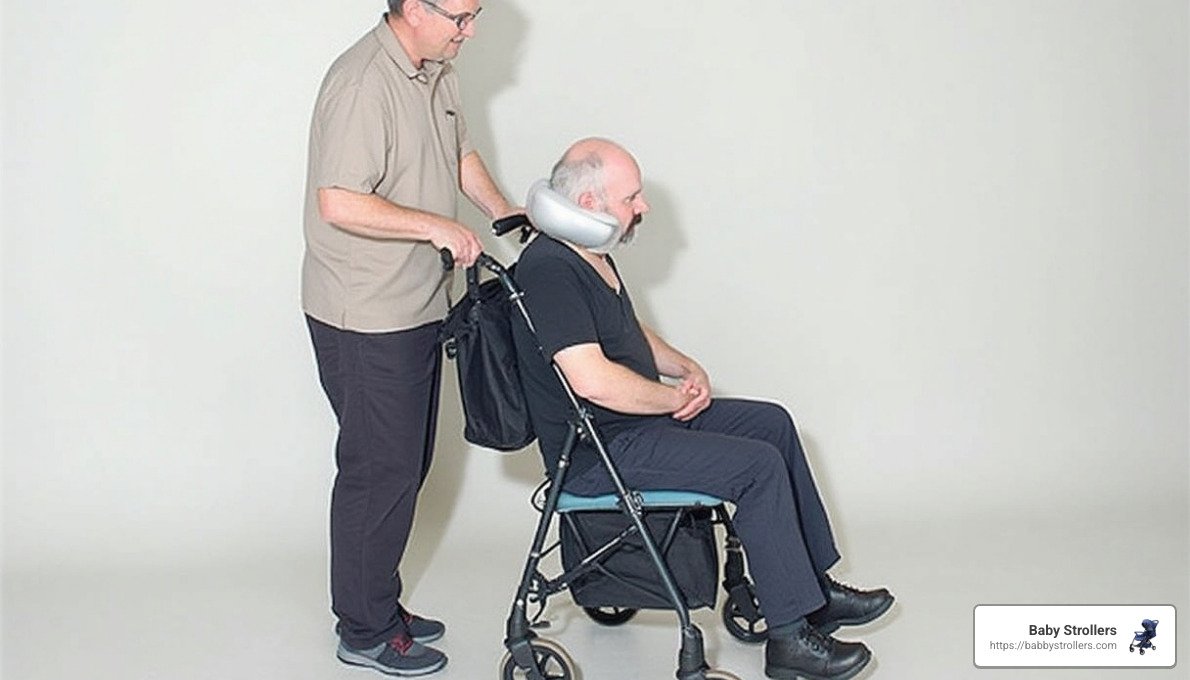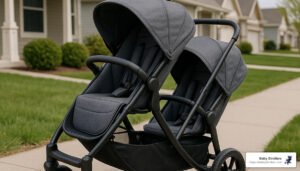Stroller with Head Support: Top 5 Essential Picks 2025
Why Infant Head Support Matters in Strollers
Stroller with head support options are designed to provide essential neck stability and comfort for babies who haven’t yet developed strong neck muscles. For parents searching for the best head support solutions, here’s what you need to know:
| Top Strollers with Head Support | Key Features | Best For |
|---|---|---|
| Doona Car Seat & Stroller | Integrated head support, air travel certified | Newborns to 35 lbs |
| UPPAbaby with Infant SnugSeat | Extra comfort for neck and back, transitions as baby grows | Compatible with Vista and Cruz models |
| Babyzen YOYO2 | Newborn pack with head support, travel-friendly | Birth to toddler age |
| Strollers with Lovenest Baby Headrest | Pediatrician-designed ergonomic support, prevents flat head syndrome | Babies 0-4 months |
When shopping for your little one, proper head support isn’t just a comfort feature—it’s a safety essential. Newborns and young infants lack the neck strength to hold their heads upright, making dedicated support crucial during stroller rides.
The right head support can:
- Prevent uncomfortable head bobbing during naps
- Support proper spinal alignment
- Reduce the risk of flat head syndrome
- Provide security during bumpy terrain
Head support options come in various forms—from built-in features to adaptable inserts that can be used with multiple strollers.
I’m James Mark, a baby product specialist with extensive experience testing and reviewing stroller with head support models for families with newborns and young infants. My work focuses on helping parents find the perfect balance of safety, comfort, and convenience in their baby transport solutions.
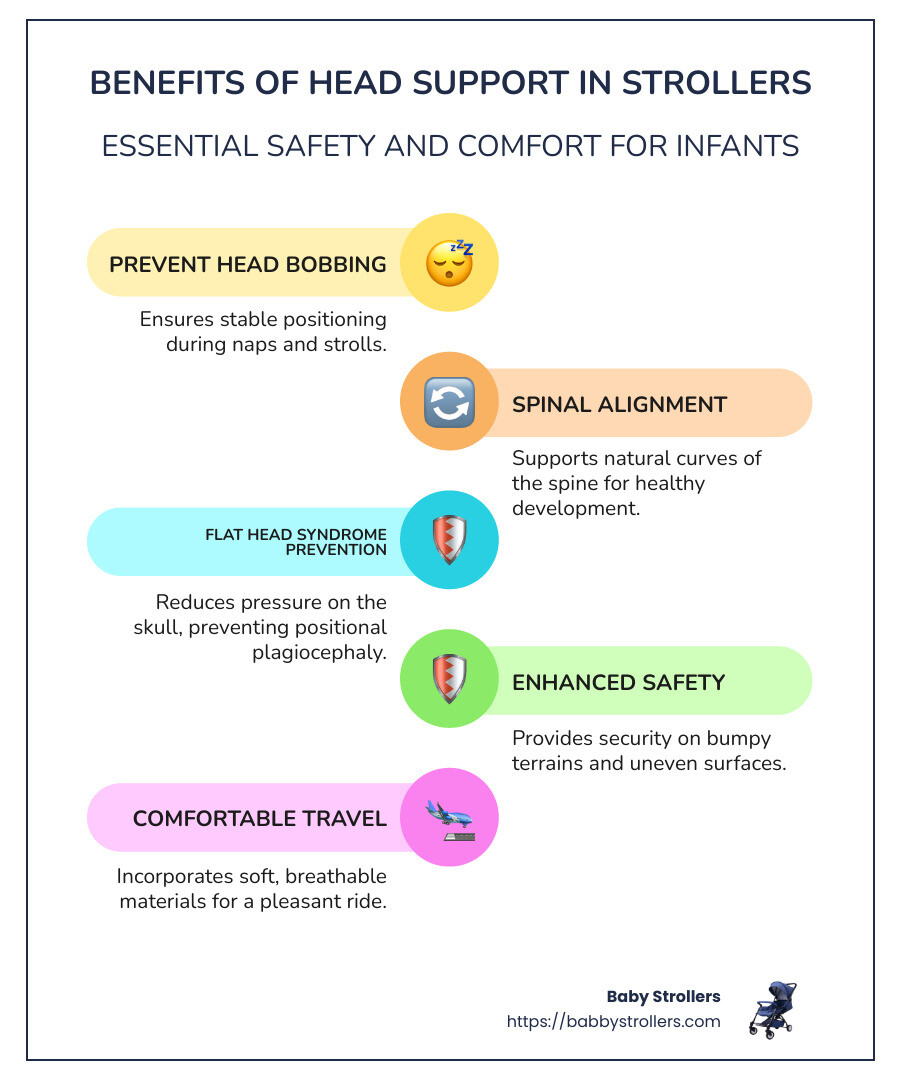
Stroller with head support vocab explained:
Why You Need a Stroller with Head Support
Picture this: you’re taking your little one out for a stroll on a beautiful spring day. As you steer the slightly uneven sidewalk, you glance down to see your baby’s head comfortably supported, sleeping peacefully instead of bobbing with every bump. That’s the difference a stroller with head support makes—and it’s more important than you might realize.
Infant Neck Development
Those tiny neck muscles? They’re still works in progress! For the first few months of life, your baby simply doesn’t have the strength to hold their head steady. Most babies start developing some neck control around 3 months, can hold their head up while sitting around 4 months, and finally master good head control by about 6 months.
Before these milestones, your little one relies completely on you for support. I remember talking with Jennifer, a first-time mom from Seattle, who told me: “I had no idea how important head support was until my pediatrician pointed out how my baby’s head was flopping to the side in our basic stroller. We immediately upgraded to a stroller with head support, and the difference in my baby’s comfort was immediately noticeable.”
Safety During Strolls
Think about how uncomfortable it would be if your head kept falling forward or to the side every time you hit a bump! Without proper support, babies experience exactly this kind of jarring motion during rides. This isn’t just uncomfortable—it can be stressful for their delicate neck muscles and spine.
A quality stroller with head support keeps your baby’s head stable and properly positioned, even when they drift off to dreamland during your walks. This stability becomes even more crucial when you’re navigating bumpy sidewalks, gravel paths, or grass at the park.
Preventing Flat Head Syndrome
Have you heard of plagiocephaly? Better known as flat head syndrome, this condition develops when babies spend too much time with pressure on one part of their skull. While we often associate this with sleep positioning, extended time in strollers without proper support can definitely contribute to the problem.
Many parents have found success with specialized head supports like the Lovenest Baby Headrest, which can be added to various stroller models. This clever device was specifically designed by a French pediatrician to address flat head concerns. One parent’s review said it all: “After using the headrest, my baby’s ear shape improved noticeably.” That’s a pretty remarkable benefit from something as simple as proper head positioning!
Ergonomic Support for Developing Spines
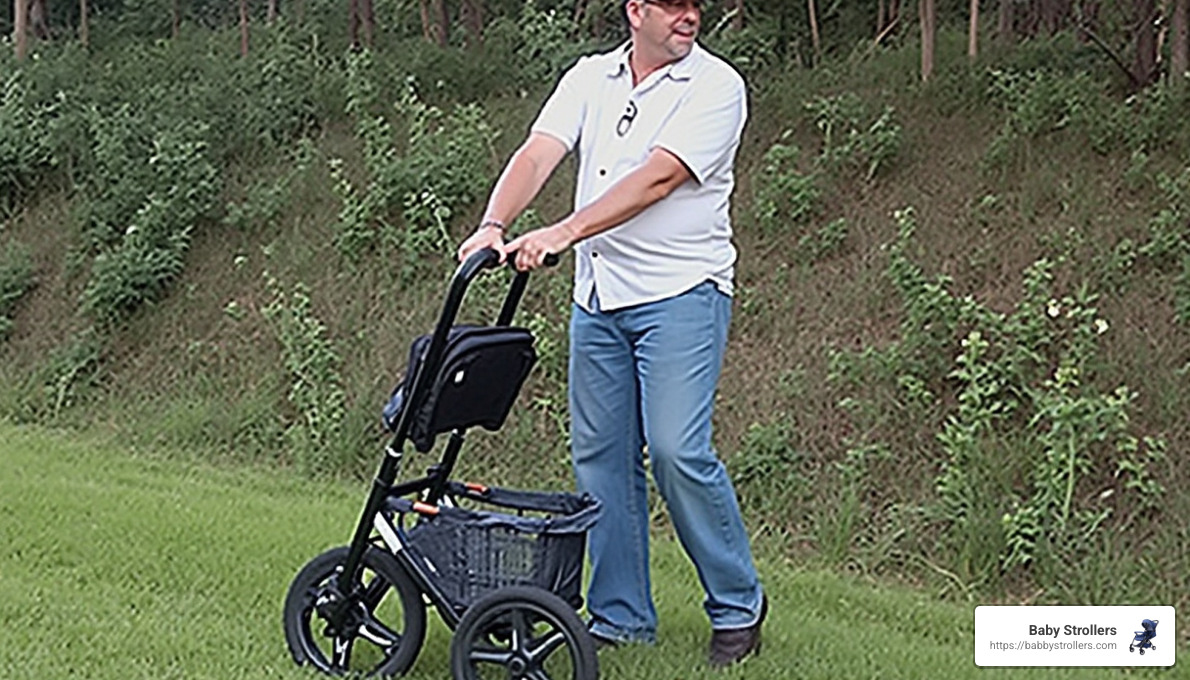
Good head support isn’t just about the head—it’s about supporting your baby’s entire developing body. The best strollers with head support are “designed in collaboration with global engineering, safety, and medical experts to mimic a natural fetal position, supporting the baby’s spine during the developmental stage.”
Take the Doona car seat and stroller system as an example. Its thoughtful design focuses on creating ergonomic positioning that supports proper spinal development from day one. By keeping your baby’s body properly aligned, these strollers help prevent unnecessary strain on their developing bones and muscles.
Peace of Mind for Parents
Let’s be honest—parenting comes with enough worries! A stroller with head support gives you one less thing to stress about. Knowing your precious little one is secure, comfortable, and properly supported lets you actually enjoy those outings together.
Roy Berenholtz, a parent who uses the NapUp head support device, put it perfectly: “Our 3-year-old daughter FINALLY can enjoy and not get cranky in our long fun road trips. This very efficient, well-made head support is easy to install, comfortable and safe. I highly recommend it!”
When you’re pushing your baby around the neighborhood or through the farmers market, that peace of mind is absolutely priceless. And isn’t that what we all want as parents—to know we’re doing everything we can to keep our little ones safe and comfortable?
Key Features to Look for in a Stroller with Head Support
Shopping for the perfect stroller with head support can feel overwhelming with so many options available. As a parent, you want to make sure you’re investing in features that truly matter for your baby’s comfort and safety. Let’s explore what really makes a difference when choosing the right head support system for your little one.
Adjustable Headrests in Strollers with Head Support
The beauty of an adjustable headrest is that it grows with your baby, providing customized support at every stage. The best strollers offer multi-position recline options that let you find that sweet spot where your baby seems most comfortable—whether they’re wide awake and curious or drifting off to dreamland.
Height adjustability is another game-changer, especially as your baby experiences growth spurts. Premium models allow you to raise or lower the headrest position to perfectly cradle your baby’s developing neck and head.
I love what Megan Johnson, mother of a five-year-old, shared about her experience: “My son is five, and it’s so simple, he can use it on his own.” That kind of user-friendly design makes life easier for everyone—which is exactly what you need during those busy parenting days!
Many thoughtfully designed systems, like the UPPAbaby Infant SnugSeat, include removable inserts that provide comprehensive support for newborns but can be adjusted or removed as your baby develops stronger neck control. This adaptability ensures your stroller remains useful long after those early months.
High-Quality Padding Materials
The materials touching your baby’s sensitive skin matter tremendously. Breathable fabrics are non-negotiable—they allow air circulation to prevent your baby from getting sweaty and uncomfortable around the head and neck, especially during warmer months or longer strolls.
For babies with sensitive skin (which is most of them!), hypoallergenic materials provide peace of mind. These gentle fabrics reduce the risk of irritation or allergic reactions while still offering plush comfort.
Memory foam and similar responsive materials take comfort to the next level. These materials gently conform to your baby’s unique head shape, providing personalized support that helps prevent pressure points.
Some innovative options like the Munchkin Brica XtraGuard even feature antimicrobial properties. As their product description cleverly notes: “Car seats and strollers are germy dirt magnets for good reason — they’re always on the go with your precious cargo!” Their silver ion infusion technology helps reduce germs on fabric surfaces—a thoughtful touch for health-conscious parents.
Safety Certifications
When it comes to your baby’s safety, certifications aren’t just nice-to-haves—they’re absolutely essential. The best strollers with head support meet stringent safety standards like ASTM and JPMA certification, which verify that the stroller meets fundamental safety requirements.
Some head support systems, particularly those designed to work with car seats, undergo crash testing. The Doona system stands out here, meeting multiple international safety standards including US – FMVSS 213, US – NPRM 213, EU – ECE R44, and AS/NZS – 8005:201. This rigorous testing provides reassurance that your baby’s support system has been thoroughly evaluated.
For families who love to travel, look for strollers with air travel certification, like the Doona car seat and stroller system. This certification means less hassle at the airport and more confidence that your baby’s gear meets aviation safety standards.
Ergonomic Design
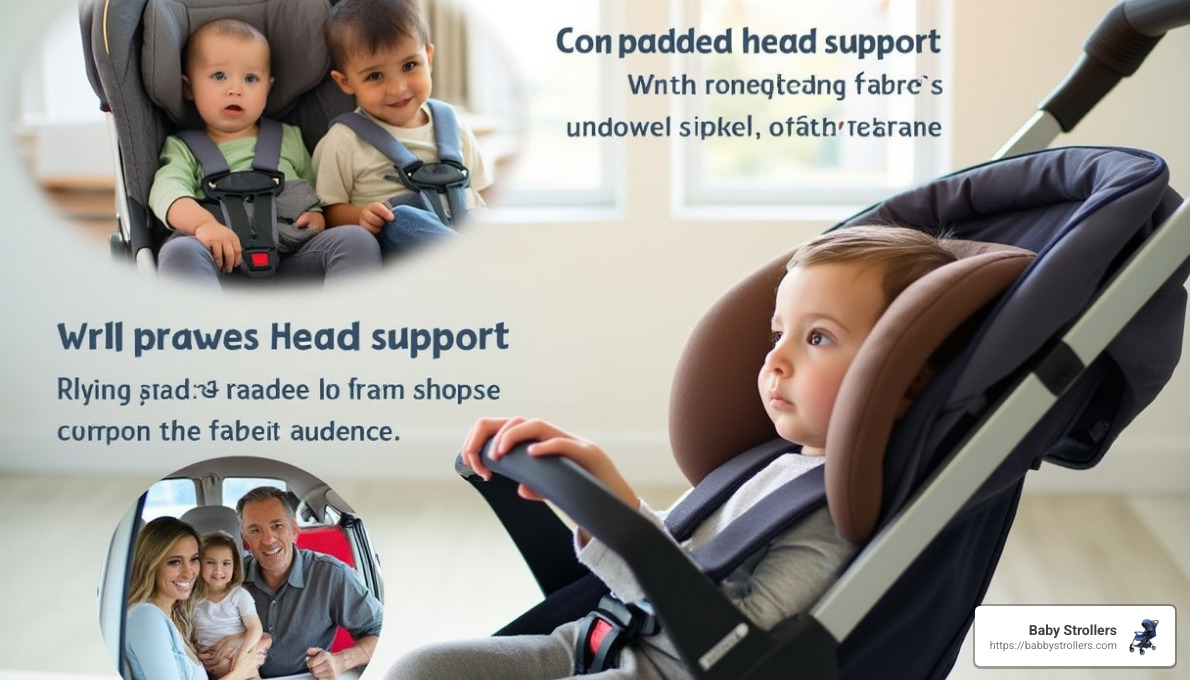
The shape of your baby’s head support isn’t just about comfort—it’s about proper development. The best supports feature a contoured shape that naturally cradles your baby’s head, mimicking the supportive touch of your own hands.
Proper neck alignment is crucial for your baby’s comfort and development. A well-designed head support maintains the natural alignment between your baby’s head and spine, preventing uncomfortable positioning that could strain their delicate neck muscles.
Side support is particularly important for younger infants who lack lateral head control. These supports prevent your baby’s head from falling to the side during naps or bumpy rides, keeping them comfortable and properly positioned.
The Lovenest Baby Headrest exemplifies thoughtful ergonomic design, having been “designed by a French pediatrician to prevent flat head syndrome” with a shape that “mimics a natural fetal position.” This medical expertise translates to better support for your baby.
Compatibility with Car Seats
For busy parents (and that’s all of us!), seamless transitions between car and stroller can make or break your day out with baby. Some models, like the Doona, brilliantly combine a car seat and stroller with built-in head support—eliminating the need to wake a sleeping baby when moving from car to stroller.
If you already have a stroller you love, look for adaptable inserts like the Infant SnugSeat by UPPAbaby, which are designed to work with specific stroller models (Vista and Cruz Toddler Seats). These add-ons let you improve your existing gear without starting from scratch.
For maximum flexibility, some aftermarket head supports work with multiple strollers and car seats, giving you the freedom to use them across different baby gear as needed.
At BabbyStrollers.com, we’ve found that parents of newborns particularly love our Stroller for Newborn options with integrated head support systems. These create the most seamless experience during those precious and challenging first months.
When you prioritize these key features, you’ll find a stroller with head support that not only keeps your baby safe and comfortable but also gives you confidence during every outing—whether it’s a quick trip to the store or an all-day trip.
How to Choose the Best Stroller with Head Support
Finding the perfect stroller with head support for your little one doesn’t have to be overwhelming. As a parent, you want to make sure your baby is comfortable, safe, and properly supported during outings—whether it’s a quick trip to the grocery store or a longer trip at the park.
Age and Weight Considerations
Your baby’s age and size play a crucial role in determining the right head support system. For those precious first weeks and months, look for newborn-specific options like the Lovenest Baby Headrest, which is specially designed for babies up to 4 months old when they need the most support.
I love hearing from parents like Jennifer Larson who found that the right head support transformed her baby’s stroller naps: “Usually, his naps only last 30 min – with the NapUp, they last almost 2 hrs.” Imagine getting that much extra time to enjoy your coffee or finish errands while your little one sleeps comfortably!
As your baby grows, convertible systems like the UPPAbaby Infant SnugSeat offer fantastic flexibility, transitioning from full support for newborns to a comfort liner for older babies. Always check the manufacturer’s weight recommendations—both minimum and maximum—to ensure your baby stays safe and comfortable.
Adjustability Features
The best stroller with head support will grow with your baby, offering customization options that adapt to their changing needs. Look for multi-stage systems that let you remove components as your little one develops stronger neck control.
The Duo Head Support system is a perfect example of smart design: “Inner and outer support can be used together for smaller babies” while the “outer support alone works for older babies.” This kind of flexibility means you won’t need to purchase new supports as your baby grows.
Quick, tool-free adjustment mechanisms are also worth their weight in gold when you’re out and about with a fussy baby. And don’t forget about recline options—multiple positions allow you to switch between upright for active time and fully reclined for those essential on-the-go naps.
Material Quality and Durability
When it comes to what touches your baby’s delicate skin, quality matters. Premium options often feature organic fabrics—like the Lovenest Baby Headrest with “95% organic cotton on the top layer and 100% polyurethane foam filling.” These materials provide both comfort for baby and peace of mind for you.
The exterior materials should stand up to regular use (and occasional abuse). Let’s be honest—baby gear gets dragged around, tossed in car trunks, and exposed to the elements. Durable materials ensure your investment lasts through your baby’s developmental stages and potentially for future siblings too.
Ease of Cleaning
If there’s one universal truth about babies, it’s that messes happen—frequently and unexpectedly! Machine-washable head supports like the Munchkin Brica XtraGuard can be a real lifesaver. Just toss it in the washing machine with cold water and line dry to maintain its antimicrobial properties.
Removable covers are another feature worth their weight in gold. They allow you to clean thoroughly without damaging the structural support underneath. Some premium fabrics even offer stain-resistant properties, making quick cleanups easier during outings when a full wash isn’t possible.
Budget Considerations
Head support options come at various price points to fit different family budgets. Built-in systems that come integrated with strollers might seem more expensive initially, but they often provide the most seamless experience and can save you from purchasing additional accessories.
If you already own a stroller you love, aftermarket head support accessories can be a more budget-friendly option to upgrade your existing gear. When considering costs, think about the long-term value—how long will this support be useful as your baby grows? At BabbyStrollers.com, we offer excellent Convertible Strollers for Babies that provide fantastic value by adapting from newborn through toddlerhood.
Actionable Steps for Choosing and Using Head Support
Before making your final decision, there are a few important steps to take:
Always follow installation instructions exactly as specified by the manufacturer. An incorrectly installed head support won’t provide the protection your baby needs and could potentially create safety issues.
Choose washable options whenever possible. Babies have a knack for creating unexpected messes, and being able to thoroughly clean their head support is essential for hygiene.
Verify safety certifications before purchasing. Look for compliance with current safety standards to ensure your baby’s protection.
Test the recline function thoroughly. For newborns without head control, a fully reclined position provides the safest and most comfortable ride.
Consider your lifestyle needs when selecting a head support system. If you’re frequently on the go or traveling, prioritize portable systems that are easy to take along while still providing excellent support.
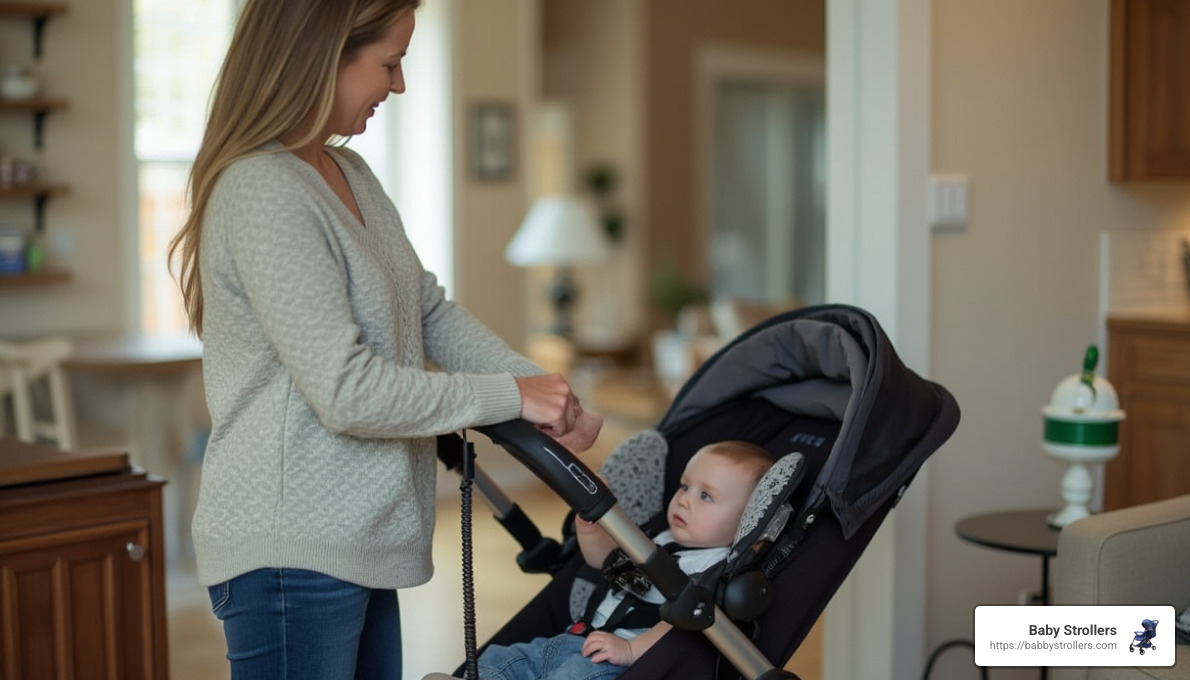
Finding the perfect stroller with head support might take a little research, but the comfort and safety it provides your precious little one makes every minute worthwhile. Your baby will thank you with peaceful stroller naps and happy outings—and as parents, we know those contented baby moments are absolutely priceless!
Frequently Asked Questions about Strollers with Head Support
Is head support necessary in strollers?
Absolutely! Head support isn’t just a nice-to-have feature—it’s essential for newborns and young infants. Think about it: those tiny humans haven’t developed enough neck strength to hold their heads steady yet. Without proper support, your little one might experience uncomfortable head bobbing during your walks, which can lead to improper spine alignment and potentially even flat spots developing on their delicate heads.
During the first 3-4 months of life, babies have almost no neck control whatsoever. That’s why proper head support in a stroller with head support isn’t merely about comfort—it’s a safety must-have. Even after your baby develops some neck control, good head support remains incredibly valuable during nap times or those longer afternoon strolls when they might doze off.
I recently spoke with Dr. Melissa Chen, a pediatrician, who explained it perfectly: “Proper head and neck support in strollers helps maintain the natural C-curve of a newborn’s spine and prevents undue stress on developing neck muscles. This is particularly important during the first few months of life when babies are at their most vulnerable.”
At what age can a baby use a stroller without head support?
Most babies develop enough head control to safely use a stroller without specialized head support around 5-6 months. But remember, every baby develops at their own pace, so it’s important to watch your little one’s individual progress rather than strictly following age guidelines.
You’ll know your baby is ready when they consistently hold their head upright while seated, maintain good head control when you gently pull them from lying to sitting, and can keep their head steady even when the stroller hits those annoying sidewalk bumps.
That said, many parents (myself included!) still prefer strollers with head support even after these milestones, especially for longer outings or nap times. Products like the NapUp head support are perfect for older babies and toddlers to prevent that head-bobbing during sleep that can wake them up just when you’ve finally gotten to enjoy your coffee!
Steffany, a mom who uses the NapUp support, told us: “Comfortable works great – if I could give 10 stars I would!” High praise that shows how valuable good head support can be even as your baby grows.
Can I add head support to a stroller that doesn’t have it?
You absolutely can! If your current stroller doesn’t include built-in head support, don’t worry—there are plenty of aftermarket options that can transform your existing stroller into a stroller with head support:
Universal head support inserts like the Lovenest Baby Headrest fit in most strollers, car seats, and bouncers, making them incredibly versatile. Strap-on systems such as the NapUp attach to existing harness systems to keep your baby’s head from slumping forward during naps. And full-body support cushions provide comprehensive support for the entire body, not just the head and neck.
When shopping for an aftermarket support, make sure it fits securely in your specific stroller model, doesn’t interfere with the safety harness, uses high-quality materials, and can be easily cleaned. The Munchkin Brica XtraGuard, for example, works with “car seats, strollers, and bouncer seats” that have 3 or 5-point harness systems—talk about flexibility!
How do I properly position my baby in a stroller with head support?
Getting the positioning right is crucial for head support to do its job properly. For newborns, always use the most reclined position available. The UPPAbaby Infant SnugSeat, for instance, “must be used with the Toddler Seat in the most reclined position” to properly support your baby.
Check that the harness straps sit at or below shoulder level for newborns, and make sure your baby’s head rests comfortably centered in the support without tilting forward. Always ensure there’s enough space around your little one’s face for proper breathing and air circulation.
Don’t forget to adjust as your baby grows! As one product manual wisely advises: “For newborns, use both the inner and outer support together. As your baby grows and develops more neck control, you can remove the inner support and use only the outer support.” Your baby’s support needs will change as they develop, so be ready to make adjustments along the way.
Are strollers with built-in head support better than aftermarket inserts?
Both have their strengths, and the right choice really depends on your specific situation.
Built-in head support systems integrate seamlessly with the stroller design and have typically been tested as part of the complete stroller safety certification process. They’re usually designed to adjust as your baby grows and match the stroller aesthetically for that cohesive look many parents appreciate.
Aftermarket inserts, on the other hand, offer fantastic flexibility—you can use them across multiple pieces of baby gear, from your stroller with head support to car seats and bouncers. They often feature specialized designs (like the pediatrician-designed Lovenest that helps prevent flat head syndrome) and tend to be more budget-friendly than upgrading your entire stroller.
If you’re buying a new stroller for your newborn, a model with built-in support like the Doona car seat and stroller system often provides the most seamless experience. Already have a stroller or use multiple baby transport devices? A quality aftermarket insert like the Lovenest Baby Headrest might be the more practical choice.
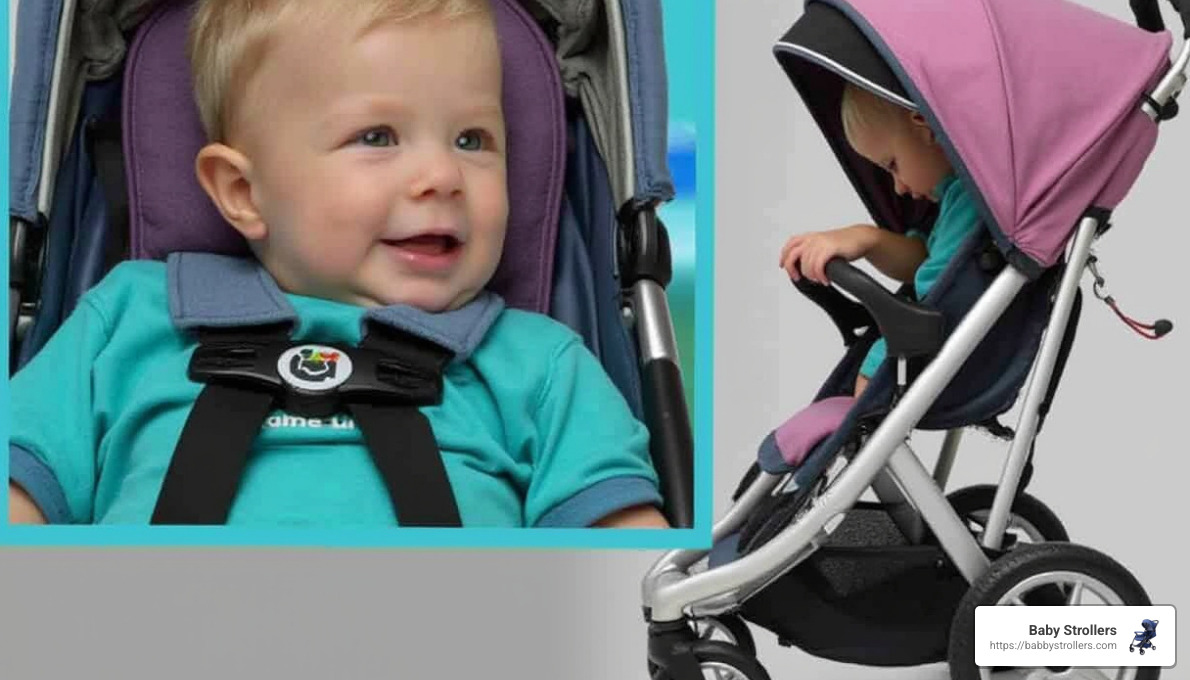
How should I clean and maintain head support in strollers?
Keeping your baby’s head support clean isn’t just about appearances—it’s about hygiene and longevity. Always start by checking the manufacturer’s specific cleaning guidelines for your model, as materials can vary widely.
For day-to-day maintenance, a quick wipe-down with a damp cloth and mild soap handles most drool, spit-up, and minor spills. For those deeper cleanings (we’ve all been there after a diaper blowout!), many supports are machine-washable—the Lovenest Baby Headrest, for example, “can be handwashed or machine washed in cold water. Only air dry the product.”
Avoid harsh chemicals that might break down the materials or irritate your baby’s sensitive skin. Always make sure the support is completely dry before reinstalling it to prevent any mold or mildew growth in those cozy crevices.
The Munchkin Brica XtraGuard offers a nice bonus with its antimicrobial properties, as it’s designed to “inhibit germ growth on fabrics” between washings—perfect for busy parents who might not have time for frequent deep cleans!
Regularly inspect your stroller with head support for any signs of wear or damage, especially around seams and attachment points. If you notice any issues, it’s better to replace the support than risk compromising your baby’s comfort and safety.
Conclusion
Choosing the right stroller with head support is a crucial decision that impacts both your baby’s comfort and safety during their first months and beyond. As we’ve explored throughout this guide, proper head support isn’t just a nice-to-have feature—it’s an essential component that supports healthy development, prevents discomfort, and gives you the peace of mind every parent deserves.
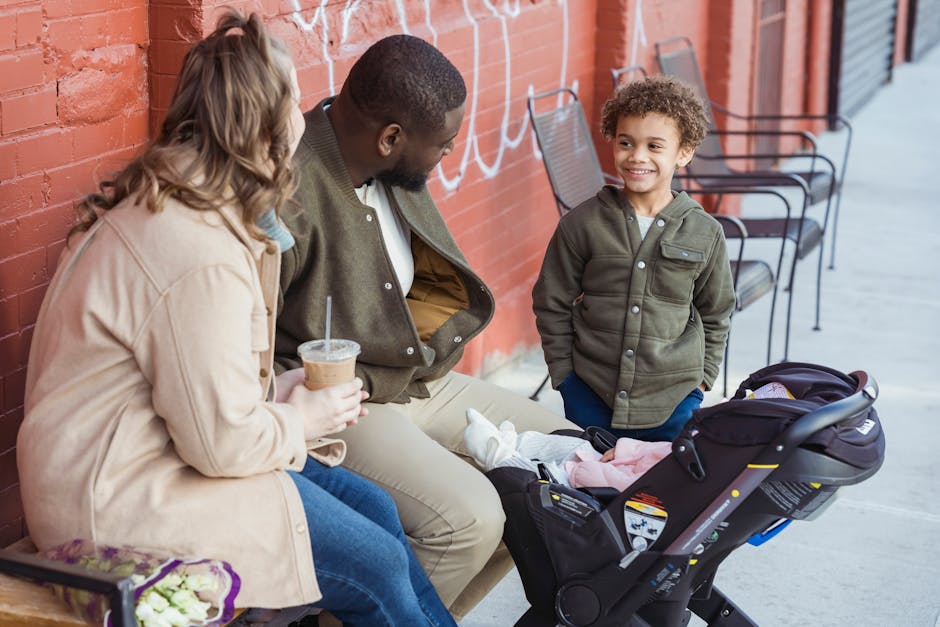
I’ve watched countless parents breathe a sigh of relief when they see their little one comfortably supported in a well-designed stroller. That moment when your baby is perfectly cradled, head aligned just right, sleeping peacefully as you steer the world together—it’s priceless.
When selecting your perfect stroller with head support, remember to consider your baby’s unique needs. A newborn requires different support than a 4-month-old who’s just beginning to control their neck muscles. Look for quality materials that feel soft against delicate skin while providing firm, reliable support. The adjustability of the head support is equally important—your baby grows so quickly in those first months!
Don’t compromise on safety certifications and testing. The strollers we’ve highlighted meet rigorous standards to ensure your precious cargo is protected during every journey. And let’s be practical—babies are messy! Choose head support that’s easy to clean and maintain through inevitable spit-ups and diaper leaks.
Your lifestyle matters too. Are you a family always on the go? Do you travel frequently? Will you be navigating city sidewalks or bumpy park trails? The right stroller should seamlessly integrate with your daily life while providing consistent support for your little one.
Whether you fall in love with an integrated system like the Doona car seat and stroller combo, add an accessory like the UPPAbaby Infant SnugSeat to your existing stroller, or choose a specialized insert like the Lovenest Baby Headrest, what matters most is finding a solution that cradles your baby’s developing body safely and comfortably.
At BabbyStrollers.com, we understand that baby gear can feel overwhelming. That’s why we’ve carefully selected quality strollers with effective head support options to meet different needs and budgets. We’re parents too, and we know how important it is to make informed decisions about your baby’s well-being.
For more information about our selection of strollers and accessories, visit More info about Baby Strollers. Our friendly team is always ready to answer your questions and help you find the perfect stroller solution for your family’s trips together.
The right stroller doesn’t just transport your baby—it becomes your trusted companion as you introduce your little one to the world around them. With proper head support, those first outings become treasured memories rather than moments of worry. Your baby deserves the very best start in life, and that includes supporting their developing body from day one.
